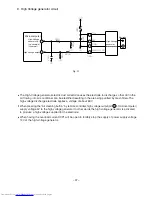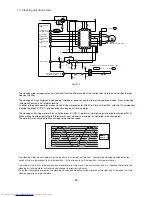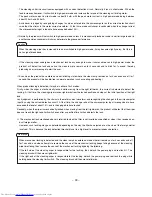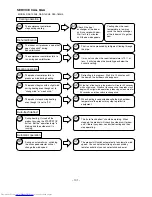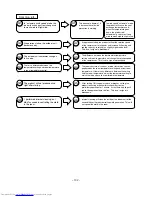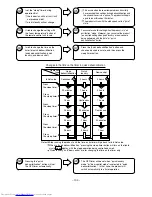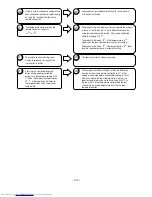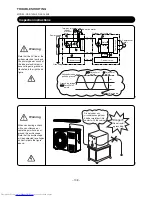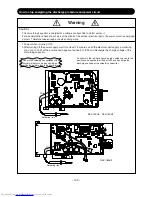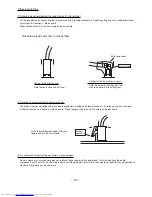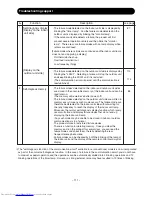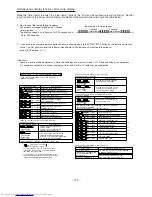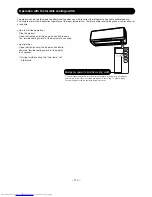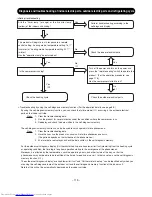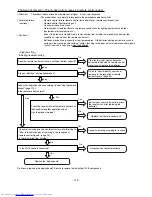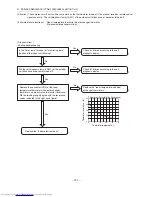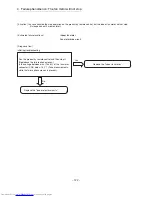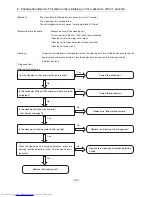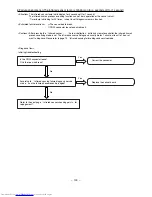
№
・
The failure mode detected on the indoor unit side is displayed by
blinking the "timer lamp". And the failure mode detected on the
outdoor unit is displayed by blinking the "monitor lamp".
・
If the outdoor unit side detects a failure, the product will first
conduct several operation retrials and then blink the "monitor
lamp". There are some failure modes with no lamp display while
retrials are continued.
[Failure mode where retrials are continued and the indoor unit lamp
does not end up giving a display]
OH thermistor heat-up
Overload lower limit cut
Low-frequency things
・
The failure modes detected on the indoor and outdoor unit sides
are stored in the nonvolatile memory of the indoor unit and can be
read later on.
(The memory will remain even after power-off.)
・
The failure modes detected on the outdoor unit side are written in
memory every time any such mode occurs. The failure mode can
therefore be detected on the indoor unit side without waiting for
the retry frequency to reach the display of the indoor unit lamp.
Moreover, the normal self-diagnosis display function which rarely
occurs will store and display failure modes that do not end up
displaying the indoor unit lamp.
(Any such mode may be unable to be stored if indoor or outdoor
communications is in a failure.)
・
The product stores 5 last-stored failure modes.
・
There is a function for deleting memory. Once you clear the
memory and run the product for several days, you can read the
failure modes and check them, thereby detecting the less
frequent failure phenomena.
・
Failure modes can be checked by both the blinking of the lamp of
the indoor unit and the display of the remote control liquid crystal
display.
・
The failure mode detected on the outdoor unit side is displayed by
blinking the "LD301". Detecting a failure will stop the outdoor unit
and keep blinking the LD301 until it is restarted.
(The communication error will persist until the communication is
reestablished.)
※
The "self-diagnosis function of the communication circuit" available in our conventional models is now incorporated
as part of the normal self-diagnosis function. In the case of a failure in the communication circuit, you do not have
to conduct a special operation and the operations can be automatically divided into 3 blinking operations and 12
blinking operations of the timer lamp. However, a strong external noise may have resulted in 12 times of blinking.
1
2
Troubleshooting support
Function
Description See
page
Self-diagnosis display
[Display on the indoor
unit side]
[Display on the
outdoor unit side]
Self-diagnosis memory
– 111 –
87
113
114
88
Summary of Contents for RAC-10SH3
Page 57: ... 55 MODEL RAC 18SH3 Unit mm 580 5 600 345 299 19 5 ...
Page 60: ... 8 5 WIRING DIAGRAM MODEL RAS 10SH3 3 H S 4 1 S A R 3 H S 8 1 S A R INDOOR UNIT ...
Page 62: ... 0 6 MODEL RAC 18SH3 OUTDOOR UNIT WHT YEL RED INDOOR UNIT ...
Page 64: ... 2 6 3 H S 8 1 S A R 3 H S 4 1 S A R 3 H S 0 1 S A R L E D O M ...
Page 150: ... 8 4 1 MODEL RAC 18SH3 ...
Page 153: ...HHAW NO 0060E RAS 10SH3 RAC 10SH3 RAS 14SH3 RAC 10SH3 RAS 18SH3 RAC 18SH3 ...

